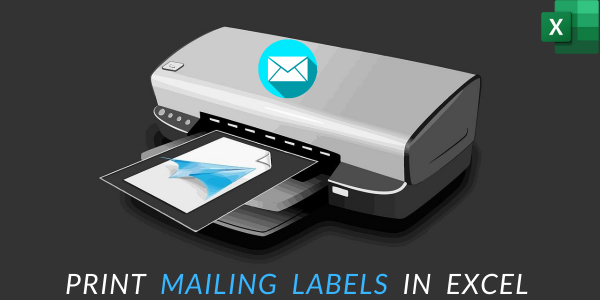5 Simple Steps to Print Mailing Labels from Excel

When it comes to organizing mailing campaigns or managing customer databases, Excel often stands as the go-to tool for professionals. One of the less explored but highly valuable features of Excel is its capability to create mailing labels directly. This process can streamline your workflow, saving time and reducing the likelihood of errors. Here's how you can leverage Excel to print your mailing labels with ease.
Step 1: Organizing Your Excel Spreadsheet

Before diving into the label printing process, you need to ensure your Excel sheet is structured correctly:
- Columns for Names: Create columns with labels such as “First Name,” “Last Name.”
- Address Fields: Include “Street,” “City,” “State,” or “Province,” and “Zip Code” or “Postal Code.”
- Proper Formatting: Check for any extra spaces, inconsistent capitalization, or incorrect formatting.
Step 2: Preparing Labels

Labels come in various sizes and formats. Here’s how to prepare them:
- Decide on the label type based on your printer and needs. Common sizes include Avery 5160 or similar.
- Visit the website of your label manufacturer for their specific templates or download them from the label software.
- Ensure the label template matches your Excel data.
Step 3: Mail Merge

Mail Merge is an incredibly useful feature in Microsoft Word that integrates with Excel. Here’s how to use it for label printing:
- Open Microsoft Word and navigate to the Mailings tab.
- Select Start Mail Merge then Labels. Choose the label vendor and product number.
- Select Select Recipients and choose Use an Existing List to locate your Excel file.
- Insert the merge fields from your Excel into the label layout:
- Click Insert Merge Field and select each field from your Excel sheet.
- Format and align the fields as needed within each label cell.
Step 4: Preview and Adjust Labels

It’s crucial to preview before printing to avoid mistakes:
- Click Preview Results in Word to see how your labels will look.
- Adjust alignment, spacing, or font size if needed for readability.
- Ensure that each label contains all necessary information accurately.
Step 5: Printing Labels

After reviewing your labels:
- Select Finish & Merge then Print Documents.
- Choose the printer settings suitable for your labels’ material.
- Click OK to start printing.
🖨 Note: Double-check your printer settings for label compatibility as incorrect settings can lead to misaligned or stuck labels.
In today's fast-paced world of marketing and customer communication, mastering the art of efficient data handling can be a game-changer. Printing mailing labels directly from Excel is a prime example of how digital tools can simplify traditional mailing processes. By following these five simple steps, you can seamlessly integrate your Excel data into your mailing labels, ensuring accuracy and saving time. Whether you're preparing a small mailing campaign or managing a large database, these steps will help streamline your workflow, allowing you to focus more on strategy and less on the mundane task of label printing.
Can I print labels directly from Excel?

+
While Excel itself does not have a built-in feature for direct label printing, it’s very efficient when paired with Microsoft Word through Mail Merge.
What label sizes are available for mail merge?

+
Word supports a wide variety of label sizes from multiple manufacturers like Avery, HP, etc. The specific sizes depend on the templates available.
How can I ensure my labels are aligned correctly?

+
Use the printer settings to align the labels. Also, you can test print on plain paper and check against the label sheet for alignment adjustments.